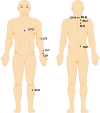Research on the Mechanism and Application of Acupuncture Therapy for Asthma: A Review
- PMID: 38828396
- PMCID: PMC11144428
- DOI: 10.2147/JAA.S462262
Research on the Mechanism and Application of Acupuncture Therapy for Asthma: A Review
Abstract
Asthma is a high-risk disease based on airway hyperresponsiveness (AHR). In this review, we found that there are many studies on clinical therapy for asthma that focus on the efficacy of acupuncture therapy and its mechanisms, including the functional connectivity of different brain regions, with the aid of functional magnetic resonance imaging (fMRI), immune responses/cell recognition (innate lymphoid cells and balance of Th1/Th2 and Treg/Th17), intracellular mechanism (autophagy, endoplasmic reticulum stress, and epigenetic alteration), and ligand-receptor/chemical signaling pathway (neurotransmitter, hormone, and small molecules). In this review, we summarized the clinical and experimental evidence for the mechanisms of acupuncture therapy in asthma to offer insights into drug discovery and clinical therapy. Given the paucity of clinical studies on the mechanisms of acupuncture in the treatment of asthma, this review notably included studies based on animal models to investigate the mechanisms of acupuncture in the treatment of asthma.
Keywords: acupoint; acupuncture therapy; asthma; fMRI; mechanism.
© 2024 Wang and Jin.
Conflict of interest statement
The authors report no conflicts of interest in this work.
Figures






Similar articles
-
Inhibiting ATG5 mediated autophagy to regulate endoplasmic reticulum stress and CD4+ T lymphocyte differentiation: Mechanisms of acupuncture's effects on asthma.Biomed Pharmacother. 2021 Oct;142:112045. doi: 10.1016/j.biopha.2021.112045. Epub 2021 Aug 18. Biomed Pharmacother. 2021. PMID: 34426257
-
Acupuncture Attenuated Inflammation and Inhibited Th17 and Treg Activity in Experimental Asthma.Evid Based Complement Alternat Med. 2015;2015:340126. doi: 10.1155/2015/340126. Epub 2015 Nov 3. Evid Based Complement Alternat Med. 2015. PMID: 26612993 Free PMC article.
-
Acupuncture Regulates the Balance of CD4+ T Cell Subtypes in Experimental Asthma Mice.Chin J Integr Med. 2019 Aug;25(8):617-624. doi: 10.1007/s11655-018-3055-6. Epub 2018 Dec 5. Chin J Integr Med. 2019. PMID: 30519873
-
A Review on the Immunomodulatory Mechanism of Acupuncture in the Treatment of Inflammatory Bowel Disease.Evid Based Complement Alternat Med. 2022 Jan 15;2022:8528938. doi: 10.1155/2022/8528938. eCollection 2022. Evid Based Complement Alternat Med. 2022. PMID: 35075366 Free PMC article. Review.
-
The Mechanisms of Effector Th Cell Responses Contribute to Treg Cell Function: New Insights into Pathogenesis and Therapy of Asthma.Front Immunol. 2022 Jul 11;13:862866. doi: 10.3389/fimmu.2022.862866. eCollection 2022. Front Immunol. 2022. PMID: 35898499 Free PMC article. Review.
Cited by
-
Effectiveness and safety of acupuncture and related therapies for pediatric asthma: a systematic review and meta-analysis.Front Med (Lausanne). 2025 Jul 16;12:1626830. doi: 10.3389/fmed.2025.1626830. eCollection 2025. Front Med (Lausanne). 2025. PMID: 40740962 Free PMC article.
References
Publication types
LinkOut - more resources
Full Text Sources

